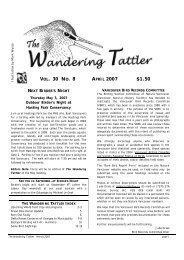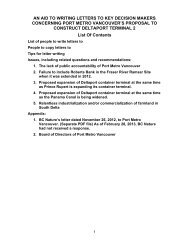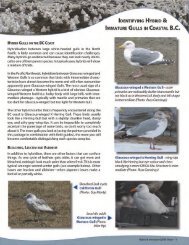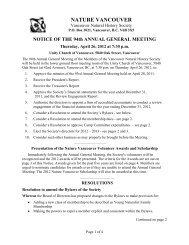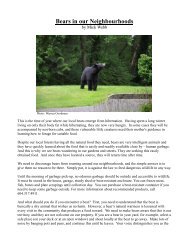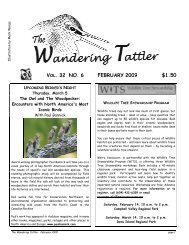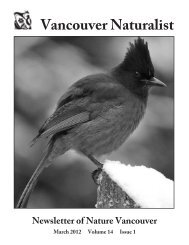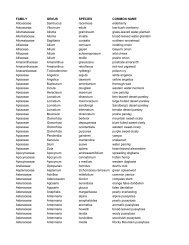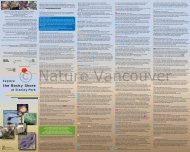Wandering Tattler - November 2011.pdf - Nature Vancouver
Wandering Tattler - November 2011.pdf - Nature Vancouver
Wandering Tattler - November 2011.pdf - Nature Vancouver
Create successful ePaper yourself
Turn your PDF publications into a flip-book with our unique Google optimized e-Paper software.
THE TRUTH ABOUT B.C. SOCKEYESALMON—WILL IT BE FOUND?Salmon spawning at Weaver Creek..By Anne Murray, September 19, 2011The future survival of the Fraser River’s wild salmon is ofoutstanding importance to British Columbia. This billion-dollarresource is priceless in terms of the ecosystem as a whole;salmon are more than just fish, they are a provincial icon.Fraser sockeye salmon had a great spawning run in 2010, with34 million returning adults, three times as many as predicted.Yet this was a huge change from the preceding years, whichsaw an unprecedented and unexplained slump from an averageof eight million spawners prior to 1992 to a mere 1.7 million in2009.What is behind this extraordinary volatility andunpredictability? Has the problem that caused the declinebeen solved, or will it return? Justice Bruce Cohen’sCommission of Inquiry into the Decline of Sockeye Salmon inthe Fraser River was instructed to find answers; the mostrecent round of evidentiary hearings, covering aquaculture, hasjust been completed.Attributing causal effects is complicated by the sockeye’s lifecycle being distributed over marine, estuarine, and riverhabitats, with a four-year abundance cycle. The commission isconsidering 26 major reports and hundreds of submissions onfactors implicated in the sockeye’s decline, including overfishing,disease, environmental changes and pollution, theimpact of fish farms located on migration routes, climatechange, and the Department of Fisheries and Oceans’ policiesand management.Any conclusion on the cause of the sockeye decline must takeinto account their sudden rebound and it is feasible that morethan one factor is involved. A disease outbreak is a highlyplausible, and complex, candidate. Pathogens may not causefatalities until an additional stress, perhaps fromenvironmental factors, such as high water temperature orpollution, tips the balance. Alternatively, rapid, virulent diseaseoutbreaks can occur among populations lacking immunity,despite an apparently healthy environment. Fungal diseases,such as chytridiomycosis in frogs and white nose syndrome inbats, have spread around the world, causing extirpations andpopulation collapse in newly exposed populations. Honey beecolonies worldwide have been struck by Colony CollapseDisorder, associated with bee paralysis viruses. In this case,environmental factors, such as an introduced Asian mite calledVarroa destructor, pesticides, and stress seem to contributeto hive collapse.If a pathogen outbreak is a cause, any role that salmonaquaculture plays in spreading the disease must be examined,given that open-net-cage facilities lie on migration paths ofFraser River sockeye. Aquaculture includes Atlantic salmon, aswell as chinook and some other species, and was begun byNorwegian investment in the early 1980s. From 1989 to ’92, adrop in the price of salmon meant consolidation into largerfacilities, with just a few owners. This was the same time thatwild fish productivity began to plummet.Pathogens with the most serious impact on sockeye includeviruses, bacteria, and parasites. Infectious hematopoieticnecrosis (IHN) virus outbreaks caused significant mortalitiesin Atlantic salmon farms near Campbell River from 1992 to2001, and have also been found in juvenile sockeye and chum infreshwater. The salmon leukemia virus is linked withplasmacytoid leukemia (infectious salmon anemia), which iscommon among seawater pen-reared chinook in Chile, Scotland,and Canada, and is also found in wild salmon. Outbreaks of thisdisease have caused death rates approaching 100 percent, andrequire total eradication of a farm’s stock to prevent spread.For long-term sustainability of all fish, regulatory governmentdepartments, and the aquaculture industry should be as openas possible about such problems. This has not been the case.The B.C. provincial government chose to block the publicrelease of fish health audit records for months, until finallysubmitting to the Cohen commission. One of these recordsshows that despite a chinook salmon farm having 96 percent ofsampled fish with symptoms of anemia, no “fish healthincident” was reported or investigated. Is such a dereliction ofduty caused by unsuitably close ties between government staffand the aquaculture companies?The federal government has also attempted to controlinformation with implications for the harmful potential ofaquaculture. In 2011, Kristina Miller, a scientist with Fisheriesand Oceans Canada, and 14 co-authors published a study in thejournal Science identifying a genomic signature (an expressionof certain genes) in wild B.C. salmon that was predictive ofwhether the fish would survive migration and spawnsuccessfully. The authors found associations between thisgenomic signature and numerous biological processes,especially those involved in response to viral infections andassociated with lymphoblastic leukemia-lymphoma. The dataled Miller et al. to hypothesize that “elevated mortality is inresponse to a virus infecting fish before river entry and thatpersists to the spawning areas”. Science is a highly prestigiousjournal and all published papers are subject to stringent peerreview. The findings were relevant and of interest to manypeople. Amazingly, the Canadian Privy Council Office preventedThe <strong>Wandering</strong> <strong>Tattler</strong> – <strong>November</strong> 2011 page 5



